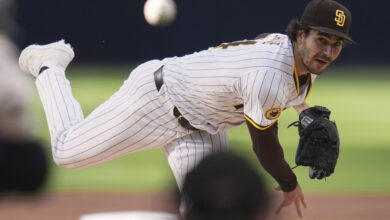
Cubs May Need to Act Fast as December 1 CBA Deadline Likely Spurring Early FA Decisions for Pitchers
With just two weeks to go before the expiration of the collective bargaining agreement, it appears as though the threat of a work stoppage and the potential for a frenzied free agency rush prior to the start of the new season may indeed be spurring movement. Jeff Passan had suggested as much in a recent piece for ESPN+, writing that both teams and agents have been leveraging the December 1 deadline as a means by which to get deals done early.
While I still believe the league as a whole secretly wants to create the same time of headline-grabbing mania we see in the NBA and NFL, individual teams may value the certainty that comes with locking key players in early. The Dodgers jumped the market for Andrew Heaney, locking up a pitcher some believe could be a Robbie Ray redux, for $8.5 million almost as soon as free agency opened.
In an even clearer signal that the pitching market is gaining steam, the Angels agreed to a one-year, $21 million deal with former Mets hurler Noah Syndergaard. Not only is that $2.6 million more than he’d have earned via the qualifying offer, but the Angels will now forfeit their second pick in next year’s draft as well as $500,000 in international bonus money. I personally find that to be a little steep for such a limited deal, but I’m just a blogger.
Not that the Angels being super aggressive with a big contract should really come as any surprise after their moves with Josh Hamilton, Albert Pujols, and Anthony Rendon, just to name a few. None of those have worked out well and the abbreviated nature of the Thor signing means it carries much less risk as they look to finally build a winner around Mike Trout.
Speaking of which, how funny is it that the Mets are hiring former Angels GM Billy Eppler to run their baseball operations just as the Angels are signing Syndergaard away from the Mets?
That’s the second contract for a pitcher who declined a qualifying offer after Eduardo Rodríguez agreed to a five-year, $77 million pact on Monday. This is one of the two biggest contracts we’ll see for a QO pitcher in terms of both years and dollars, with Ray quite possibly surpassing it. Though Ray is about 18 months older than Rodriguez, he could get more if he re-signs with the Blue Jays and avoids those pesky penalties.
Toronto has already made one big move by inking righty José Berríos to a seven-year extension worth $131 million that buys out his final arbitration season and keeps him off the market next year. That obviously isn’t the same as a free agent deal, but it’s indicative of the more general trend.
Justin Verlander and Raisel Iglesias are the only two remaining pitchers with pending QO decisions, so we’ll know by Wednesday at the latest what they decide to do there. The 39-year-old Verlander might be looking for something similar to Syndergaard given his age and injury history, while Iglesias could attempt to cash in on his big season by declining the Angels’ offer in favor of a long-term deal.
The Angels will get a compensatory pick if Iglesias signs elsewhere, the possibility of which may have helped them to be a little more aggressive in their pursuit of Syndergaard.
Bringing this back around to the market as a whole and the Cubs in particular, it appears as though we might see a lot more movement than previously expected over the next two weeks. That could mean there will be less room to let the market come to them following resolution on the CBA, whenever that comes, which is probably part of what Jed Hoyer meant when he talked about being nimble.
In other words, the Cubs may need to pounce before the focus shifts to pitchers who don’t have penalties weighing them down. One has to assume Kevin Gausman, Marcus Stroman, Jon Gray, and Steven Matz are feeling really good about their current position and may want to cash in. While that doesn’t really fit the standard concept of intelligent spending we’ve been hearing about for the last few weeks, it’s probably smarter to spend a little more now than risk having very slim pickings come February.
If, that is, the team is truly interested in putting together a competitive roster for 2022, which they absolutely should be. Setting aside talk of Corey Seager or Carlos Correa, either of whom would represent a very clear attempt at winning big in a hurry, the Cubs absolutely must upgrade the rotation in order to even think about contending for the division.
It was easy enough for the average person to see, but Hoyer openly admitted that the starters simply weren’t good enough in 2021. He also said the Cubs are prioritizing power arms, the search for which could become very difficult if it’s taking place in a rush just before camp. With so much organizational focus on pitching, it’s starting to look as though failing to make some sort of significant move(s) on that front prior to December 1 would be a big mistake.

